What is fleet electrification? (+ How to build a sustainable strategy)
Learn about fleet electrification and its benefits. Explore how transitioning to EVs can reduce costs, improve sustainability and streamline fleet management.
By Geotab Team
Jan 13, 2025
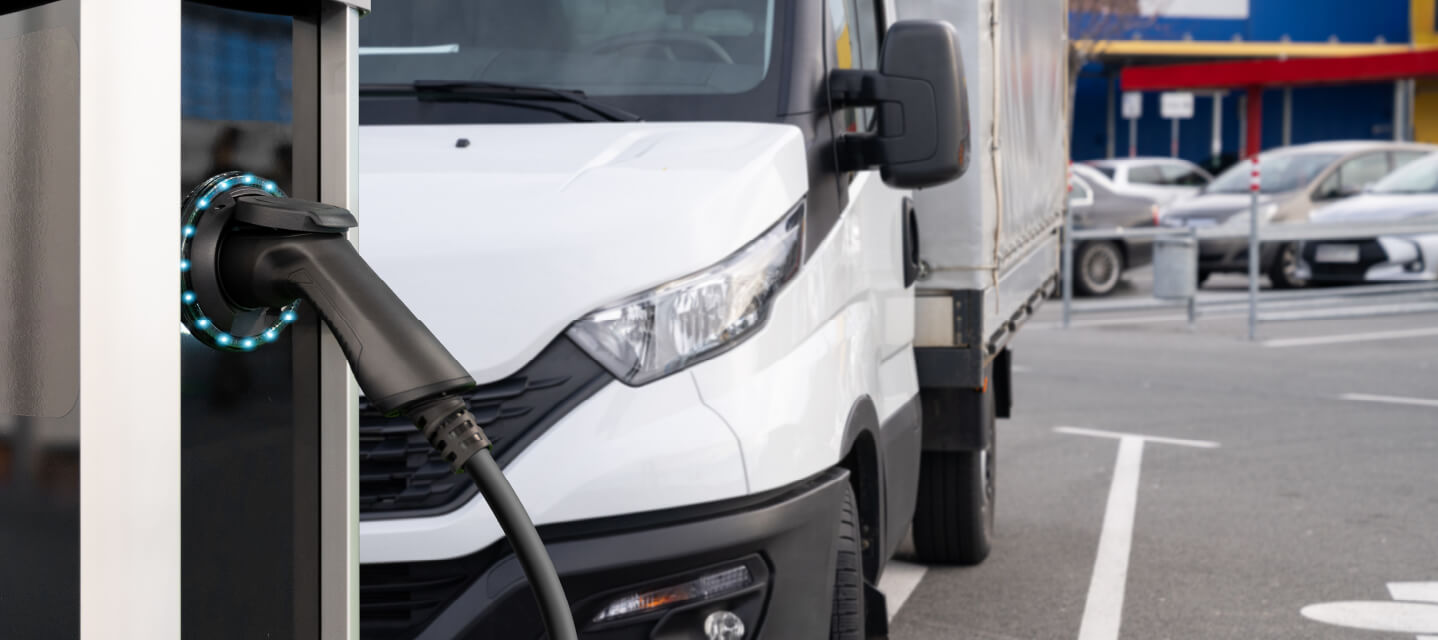
Key Insights
- Fleet electrification definition: The process of replacing traditional internal combustion engine (ICE) vehicles with electric vehicles (EVs) in a fleet. It helps reduce carbon emissions, operating costs and dependence on fossil fuels.
- Main benefits: EVs can significantly reduce maintenance costs and fuel expenses, providing long-term savings for fleet managers.
- Environmental impact: Transitioning to electric vehicles plays a key role in achieving sustainability goals and reducing the environmental impact of transportation.
Transitioning to electric vehicles, or fleet electrification, is becoming a top priority for businesses seeking greener operations and long-term cost savings. As governments and industries push for reduced emissions, many organizations are exploring the advantages of swapping out gas-powered vehicles for electric options.
Navigate the ins and outs of EV fleet management, from understanding its significance to building a sustainable electrification strategy. In this article, we’ll cover the key benefits, challenges and actionable steps to keep your fleet efficient and ready for the future.
What is fleet electrification?
Fleet electrification is the process of replacing traditional internal combustion engine vehicles in a fleet with EVs. Aside from the vehicles themselves, this transition often includes integrating supporting infrastructure, such as charging stations, and adopting technologies for efficient EV fleet management.
The goal of fleet electrification is to reduce carbon emissions, improve energy efficiency and lower operating costs over time. Companies with delivery services, public transportation systems or extensive corporate fleets, stand to gain the most from electrification.
By reducing greenhouse gas emissions, you can align with sustainability goals and comply with increasingly strict government regulations. Electrified fleets also benefit from lower fuel and maintenance costs, contributing to long-term savings.
Top benefits of fleet electrification
Fleet electrification offers a range of advantages that go beyond reducing emissions. Explore the key benefits of electrification to determine how it fits into your fleet strategy while also learning the pros and cons of electric cars.
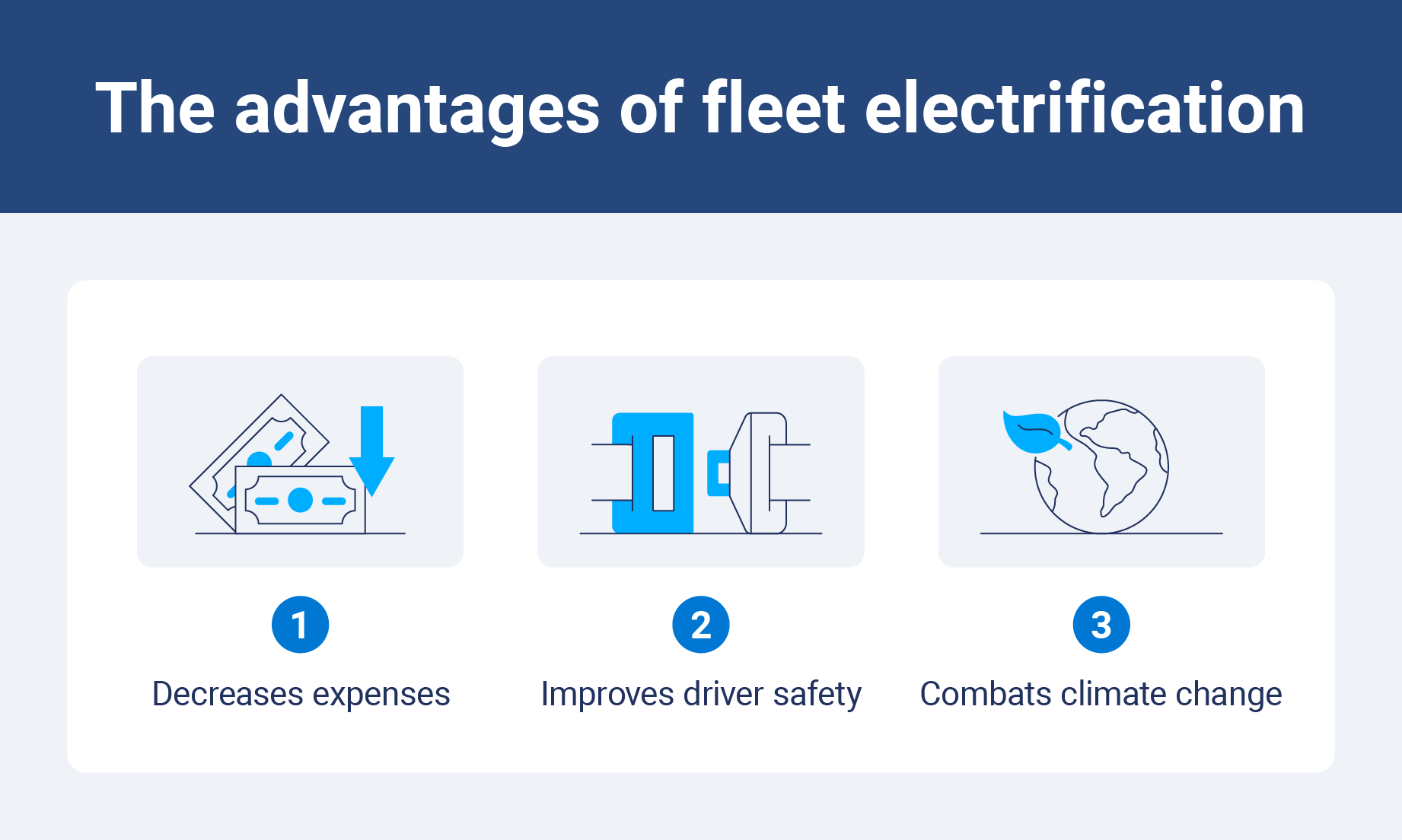
Decreases expenses
While EVs may have higher upfront costs — such as the purchase price, charging infrastructure installation and potential electrical upgrades — they offer significant lifetime savings. With fewer moving parts, EVs avoid costly maintenance like oil changes, spark plug replacements or engine repairs. Their regenerative braking systems also reduce wear on brake pads.
EVs are also more cost-efficient to operate — driving an EV costs less than half as much as a gas-powered vehicle due to better energy efficiency and lower, more stable electricity costs. Together, these savings make commercial fleet electrification a smart financial choice over time.
Improves driver safety
Safety is a priority for every business, and a well designed fleet safety program should consider the advantages of electric vehicles. EVs are generally considered safer than traditional ICE vehicles, undergoing additional safety certifications, including battery-specific tests to ensure secure placement during collisions.
The placement of EV batteries along the bottom of the vehicle lowers the center of gravity, reducing the risk of rollovers — one of the most dangerous aspects of collisions. Additionally, the absence of an engine allows for larger crumple zones, absorbing more impact and protecting passengers.
Combats climate change
Transitioning to an EV fleet is pivotal in reducing greenhouse gas (GHG) emissions, with the transportation sector responsible for 28% of all emissions.
Battery electric vehicles (BEVs) have the greatest impact, eliminating tailpipe emissions and reducing overall emissions by 30-90%, depending on the electricity source. This makes EVs essential for meeting global climate goals like those outlined in the Paris Agreement.
Beyond reducing carbon emissions, EVs also combat noise pollution. Their quieter operation helps improve driver and public health by lowering stress and reducing risks of noise-related hearing loss. By reducing your fleet’s consumption and emissions, you can support environmental sustainability and foster healthier communities.
Common EV fleet challenges
While the benefits of fleet electrification planning are clear, transitioning to an electric fleet comes with challenges. From infrastructure needs to cost considerations, addressing these hurdles early can help ensure a smooth and sustainable transition.
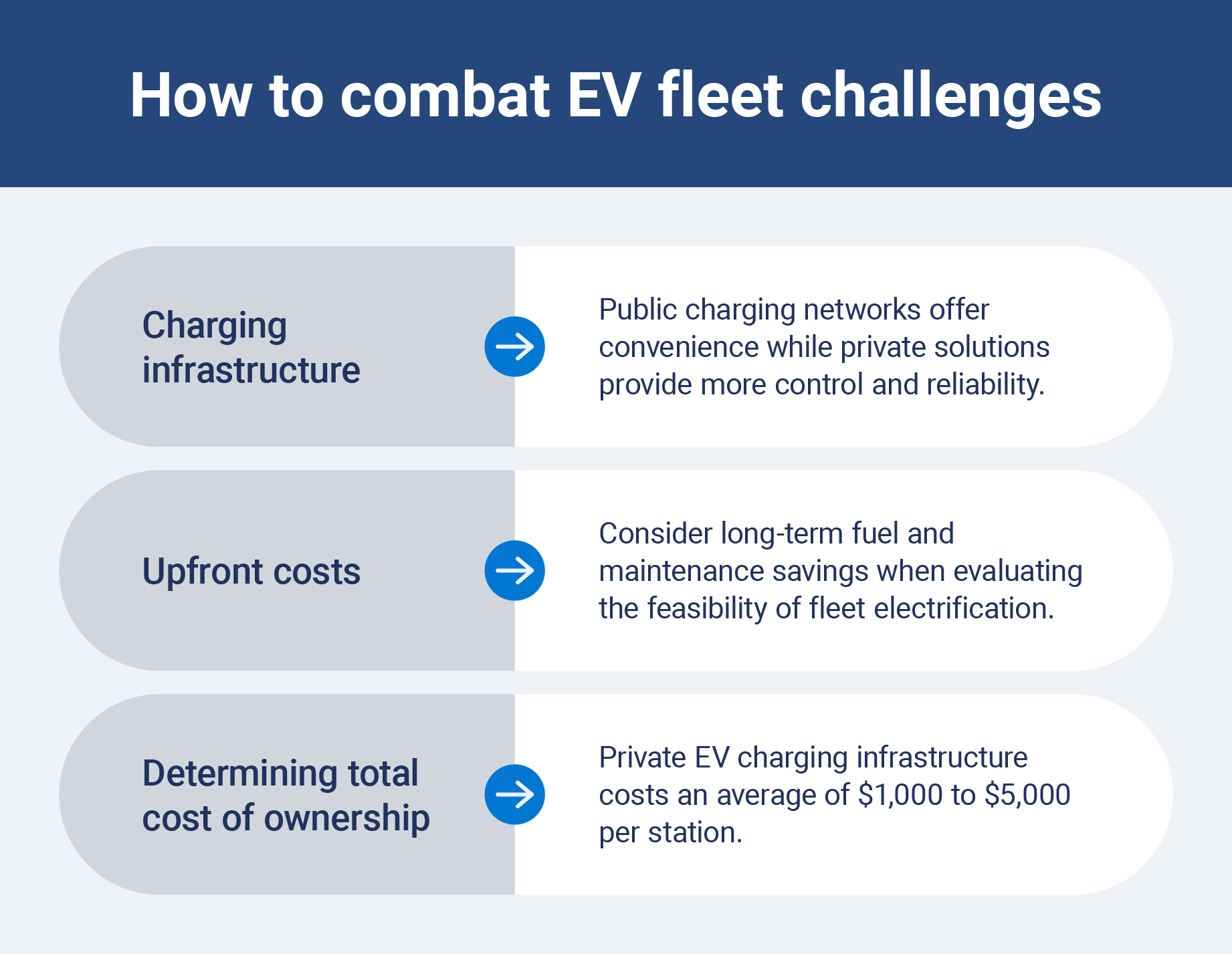
Charging infrastructure
Choosing between public and private charging solutions is a key decision in fleet electrification. Public charging networks offer convenience and accessibility, especially for fleets with vehicles operating across wide areas. However, they can also lead to unpredictable wait times and costs.
Private charging infrastructure provides more control, reliability and cost efficiency in the long run. You can tailor setups to match your fleet’s needs, ensuring vehicles are always ready to go. Although it requires upfront investment, private charging stations often pay off through reduced operational downtime and energy expenses.
Upfront costs
The initial costs of transitioning to an EV fleet can be substantial. Purchasing electric vehicles, installing charging stations and deploying training for drivers and technicians all require significant investment. For businesses accustomed to ICE fleets, these upfront expenses may feel daunting.
However, strategic planning and available incentives, such as government subsidies or tax breaks, can help mitigate these costs. Considering long-term savings and potential operational efficiencies is essential when evaluating the financial feasibility of fleet electrification.
Determining total cost of ownership (TCO)
Calculating the total cost of ownership is crucial for understanding whether the benefits of fleet electrification outweigh the investment. TCO considers factors like vehicle purchase price, maintenance, charging costs and potential savings from reduced fuel expenses and tax incentives.
By carefully analyzing TCO, you can make data-driven decisions to determine the financial viability of your electric fleet. A well planned approach ensures that investments lead to long-term savings and align with your broader sustainability goals.
How to create a fleet electrification strategy
Fleet electrification can seem overwhelming, but a solid strategy simplifies the process. The long-term benefits far outweigh the initial hurdles, and researching available options is the first step toward success. Here are some key steps to build your own electrification strategy:
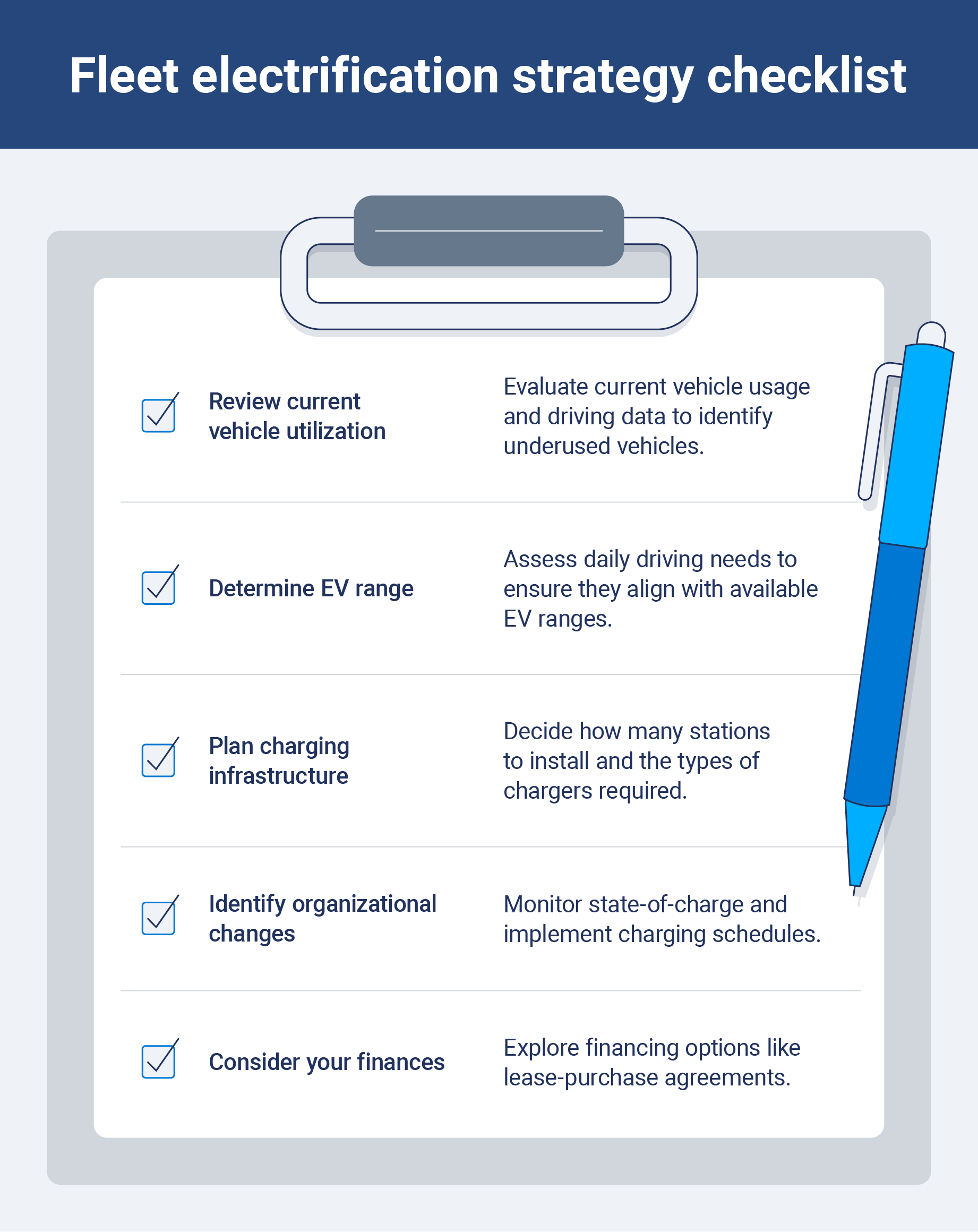
1. Review current vehicle utilization
When considering electrifying a fleet, start by analyzing your current vehicle usage. Evaluate driving data to identify underused vehicles or opportunities for right-sizing.
For example, replacing multiple vehicles with a single EV can reduce your carbon footprint and operating costs. Also, proper fleet asset utilization ensures a smoother transition while optimizing your resources.
2. Determine EV range
Range is a key factor in your fleet electrification plan. Assess each vehicle’s daily driving patterns to ensure they align with available EV ranges.
Consider seasonal impacts like winter conditions, which can reduce battery performance. Proper planning for EV winter-proofing will help your fleet remain efficient year-round.
3. Plan charging infrastructure
Planning charging infrastructure is one of the most complex aspects of EV charging. You’ll need to decide how many stations to install, their optimal placement and the types of chargers required.
Consult utility companies early to understand regulatory requirements and secure any permits. Utilities may also offer special rates or EV-related programs to help reduce costs.
4. Identify organizational changes
Fleet electrification isn’t just about the vehicles — it requires operational updates. Monitor new data such as state-of-charge and charging history, and implement defined charging schedules.
Train your drivers on best practices to ensure EVs are always ready for duty. Telematics solutions can streamline processes by providing alerts for issues like missed charging sessions, ensuring your fleet electrification roadmap stays on track.
5. Consider your finances
Financial planning is crucial for a successful transition. Explore financing options like operational leasing or lease-purchase agreements to cut fleet costs with telematics and other tools.
Additionally, consider partnering with a fleet management company or “electrification-as-a-service” provider. These services handle procurement, maintenance and infrastructure management at a single fee, simplifying the process and reducing risk.
To kick things off and learn how to electrify a fleet, you can download our ebook: The Complete Fleet Electrification Roadmap.
Electrify your fleet with the help of fleet management software
Fleet electrification is a powerful step toward sustainability and cost savings, but managing the transition effectively requires the right tools, such as fleet management software.
These tools provide data visualization to track EV performance, monitor charging schedules and ensure compliance with safety standards. All these insights streamline your operations and help you maximize your long-term savings.
Subscribe to get industry tips and insights
Frequently Asked Questions
Electrification is vital for lowering operating costs, reducing greenhouse gas emissions and supporting global climate goals. Transitioning to EVs offers long-term economic benefits while helping improve sustainability.
EVs are ideal if your fleet has predictable routes, manageable daily mileage and access to charging infrastructure. Conducting a utilization review and considering range requirements can help determine suitability.
As of now, around 20% of fleet vehicles worldwide are electric, but this number is growing rapidly due to technological advancements and increased adoption of sustainability initiatives.
The Military Vehicle Fleet Electrification Act is a U.S. legislative initiative aiming to transition military non-tactical vehicles to electric power. The goal is to reduce fuel costs, decrease reliance on fossil fuels and enhance energy security.
The Geotab Team write about company news.
Table of Contents
Subscribe to get industry tips and insights
Related posts


The future of transportation: Trends, research and what’s next according to experts
July 17, 2025
9 minute read
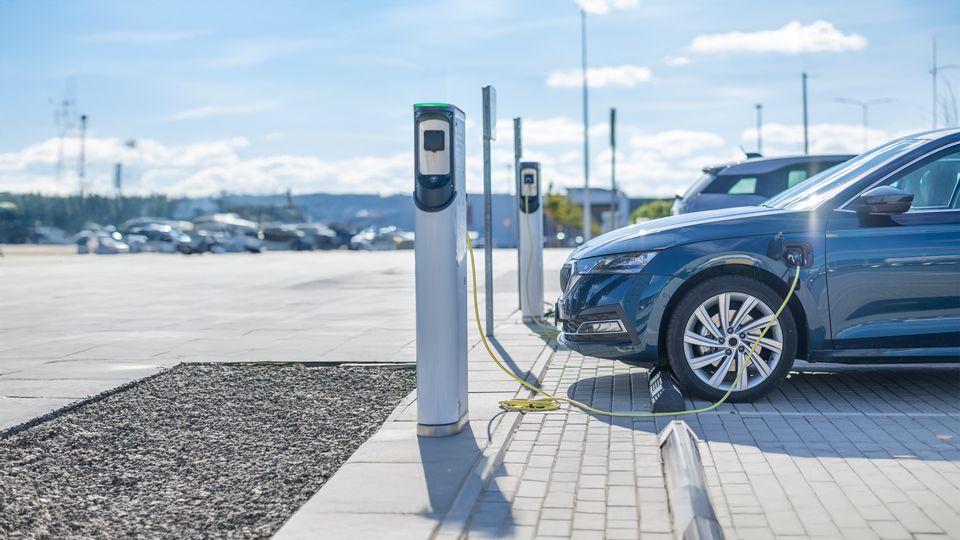
Beat the Heat: Easy Ways to Maximize Your EV Range This Summer
June 19, 2025
2 minute read

Charlotte Argue: Breaking down cost barriers for electric fleets
June 5, 2025
4 minute read

